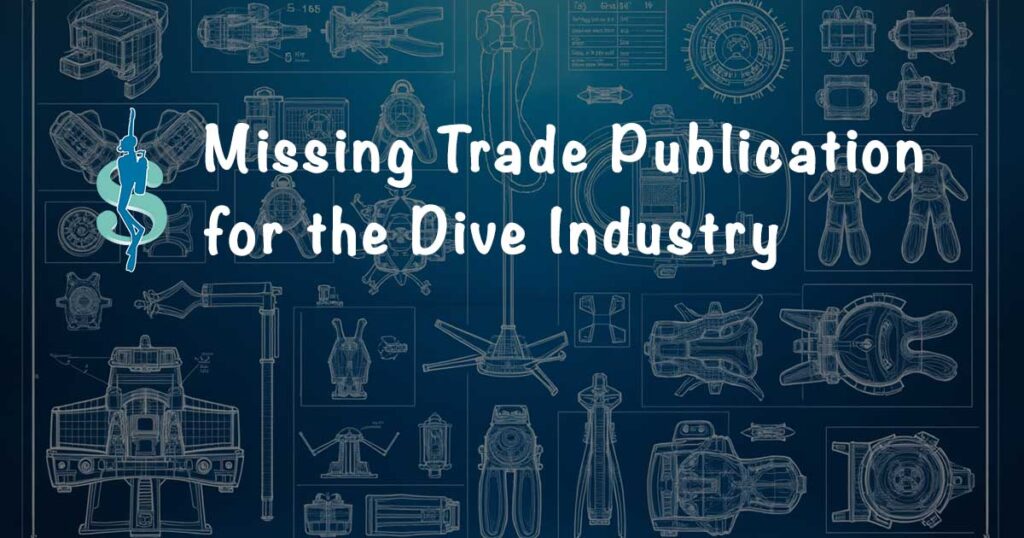The Missing Scuba Diving Industry Trade Publication
What publications do we have in the scuba diving industry? What would be a dive industry trade publication?
Part of the reason why we lack dive industry statistics and market data is that we do not have a real dive industry trade publication digging and sharing impartial information and statistics on the dive industry.
This post is part of our Shifting Tides: Dive Industry Assessment & Strategies for Today’s Scuba Divers series by the Business of Diving Institute and Darcy Kieran, author of:
Table of Contents
What Would Be a Dive Industry Trade Publication?
A trade publication includes information that is of no interest to the general public but is highly valuable for professionals in that industry. By publication, nowadays, we mean printed or online, including podcasts.
In an industry trade publication, you find information on changes in the marketplace, trends, financial results of companies in that industry, changes in executives in those companies, changes in consumer expectations or demands, mergers and acquisitions, etc.
A trade publication allows you to keep your finger on the pulse of the industry – economic, financial, marketing, human resources and more.
In the Outdoor Industry, there are numerous ones. Just Google “Outdoor Industry Trade Publication” and you’ll find quite a few. The same applies to the Sporting Goods Industry.
For instance, in an edition of SGI Weekly Intelligence (SGI stands for Sporting Goods Industry), we found that Head (the parent company of Mares & SSI) had a 5% increase in sales but a 46% decline in net income. You also read that the Mares/SSI division gained 9% in revenues to about $70M — but it was due to the integration of the revenues from the newly acquired SSI business, while there was a decline in gear sales.
Where do we find that kind of information in the dive industry? Where do we find the economic pulse of our industry? I mean, besides the market reports we publish on the Dive Industry Compass of the Business of Diving Institute website.
Just look at the “areas of coverage” by SGI News. Tell me if having this kind of information in a dive industry trade publication would help you manage your scuba diving business. Right. It would be precious.
What Publications Do We Have in the Scuba Diving Industry?
We have quite a few good scuba diving publications. We just do not have a dive industry trade publication. Let’s have a look at what we have.
Publications for Scuba Divers (Consumers)
We have a few scuba diving publications dedicated to consumers, like The Scuba News.
These businesses live by selling advertising, mainly to dive gear manufacturers and dive resorts. Articles in those magazines are always “positive.” The publisher’s goal is to communicate the passion for scuba diving to consumers and please their advertisers. It’s fine. But they do not cover what a dive industry trade publication would.
Besides living from ads, some of these consumer magazines are a promotional arm for a dive training agency. For instance, Sport Diver was the official publication of the PADI Diving Society until the Society died. And Scuba Magazine is the official dive magazine of BSAC (British Sub Aqua Club).
With the 2019 acquisition of Bonnier’s dive media brands (Scuba Diving, Sport Diver, and Skin Diver magazines) by PADI, it seems we have even fewer impartial consumer dive magazines.
One magazine that all scuba divers and dive professionals should read is Alert Diver (USA) by Divers Alert Network (DAN) and Alert Diver (Europe) by DAN Europe.
The Case of InDEPTH Magazine
InDEPTH Magazine is a notable outlier for the depth of its articles. It goes beyond the fluff and passion of scuba diving to dive deep into various issues of interest to scuba divers and dive instructors.
Full disclosure: I collaborate with InDEPTH Magazine for a series of scuba-related surveys.
Although InDEPTH’s content is heavily tilted toward tech diving, as a dive professional you get information that is valuable in your career.
Training Agencies “Pro” Publications
Although they are not targeting the general public, they are very similar to consumer magazines. They “promote” whatever is suitable for the training agency that owns the magazine.
If you are a PADI client (they call you a “member”), you receive the “Undersea Journal.” It’s a beautiful magazine. Very well done. But what do you find in there? There’s nothing from the list of what a dive industry trade publication would include as discussed above. It’s mainly a pep talk, in written form. It’s a PADI medium to convince dive professionals to buy more PADI products and services — with some information about changes in teaching standards.
Dive Center Business & Scuba Diving Industry Magazine
Dive Center Business was a very special and unique magazine. It was sent to dive shop owners and managers in North America. The Dive Center Business magazine contained a lot of great articles on how to better manage your local dive shop.
Dive Center Business was shut down at the beginning of the COVID-19 pandemic. A few years later, Scuba Diving Industry Magazine was created by a different publisher but with a similar content. If you do not already read it, I strongly suggest you start.
But is it a dive industry trade publication? Although it is written for and distributed to dive industry insiders (local dive shops in the USA), it still doesn’t contain what we discussed above. It’s a management tool for dive center managers and instructors, not a comprehensive dive industry trade publication.
Dive News Wire
Dive News Wire markets itself as the “Industry’s News Source,” and it does, indeed, contain valuable information. If you are in the dive industry and you do not receive it, subscribe. It’s free.
But it’s free because it’s a press release distribution service. It’s not an independent trade publication. Dive industry companies pay for their press releases to be distributed on Dive News Wire.
Undercurrent
Undercurrent is another particular beast.
This online magazine covers some of the topics a dive industry trade publication would cover, sometimes. For instance, it wrote about a lawsuit against Suunto regarding their dive computers. The juicier the subject, the more likely Undercurrent will cover it.
However, their primary focus is on reviews of dive destinations for scuba divers.
The Case of Scubanomics
A few years back, I dreamed of helping the dive industry by publishing in Scubanomics the kind of articles you would expect in a scuba diving trade publication.
For instance, I covered how a private equity firm destroyed the largest dive gear brand (Aqua Lung). Earlier, I covered the mysterious, hidden billionaire owners behind PADI (that post is no longer online). In both cases, the volume of traffic clearly indicated a need for a publication sharing the pulse of our industry.
However, it’s a lot of work! And I don’t sell ads. So, I haven’t worked on even updating the Aqualung post, even though that post still gets a lot of traffic.
A true trade publication would be valuable to dive industry stakeholders. But it’s not a small undertaking. You need journalists digging for the information.
Magazines a Dive Professional Should Read
A dive professional will find value in every publication mentioned above. I’m not saying there is no value in these magazines – quite the contrary.
In fact, if you are a scuba diving instructor or a dive industry professional, I strongly recommend you subscribe at least to:
- InDEPTH Magazine (free)
- Scubanomics (free)
- Scuba Diving Industry Magazine (free)
- Dive News Wire (free)
- Undercurrent (small annual fee)
However, they are not comprehensive trade publications that every industry has besides the dive industry. Scubanomics is trying to be one but… Don’t hold your breath!
What are the consequences of not having a dive industry trade publication?
There are two main consequences of not having an impartial dive industry trade publication.
No Point of Reference
By definition of what is a trade publication (above), lacking one means we have no way of keeping our finger on the pulse of the industry. By extension, we lack information and statistics about the dive industry. We are trying to compensate for that lack of market reports with our Dive Industry Compass initiative.
If we compare our business to a sailboat, I think we are sailing blindfolded. And we wonder why the dive industry has a problem with growth!
Misleading Dive Professionals
Lacking an impartial dive industry trade publication also creates overly optimistic dive pros and dive shop owners. They are being misled by the numerous “pep talks” found in magazines published by scuba diving training organizations.
New dive professionals invest in becoming an instructor and a dive shop owner, believing all the hype from the training agencies. And, then, they realize they didn’t get the whole story and wonder what they just did!
When you ask your training agency rep for help with your marketing plan, what do you get? Usually, you get a list of PADI products he thinks you should buy… today, of course!
The dive industry is sailing blindfolded while misleading dive instructor candidates and dive center owners.
What’s Next?
We are missing a dive industry trade publication. The solution is pretty simple, right? We should create one. But there are quite a few problems with that seemingly simple goal.
I’ve already mentioned the time and effort that journalists would need to put in in order to dig out real economic and financial information about the dive industry.
Furthermore, for this dive industry trade publication to be credible, it needs to be independent. It means that it must be a stand-alone business. Therefore, the question becomes: How can such a company be profitable while remaining independent?
Look at the price of a subscription to SGI News. It’s $545 annually. Meanwhile, there’s only a handful of dive shop owners who pay for a DEMA Membership. We regularly hear that such a DEMA Membership is too expensive. It’s only $200 annually. And we save at least $115 on our DEMA Show registration.
Therefore, we can assume it would be hard for a dive industry trade publication to collect subscription fees in the $500 price range.
On top of that, it’s unlikely that $500 would even be enough. The dive industry is much smaller than the sporting goods industry. With such a niche market, an independent dive industry trade publication would probably have to set its annual subscription price around $1000.
So, the question further becomes: Why is it that players in the dive industry don’t see value in industry information, data, and statistics? Could it be that we have many hobbyists and a few business people?
We need people passionate about retailing, customer service, business growth, and the like – not just about scuba diving.
Continue reading about Shifting Tides: Scuba Diving Industry Assessment & Strategies for Today’s Scuba Divers.
If you found the information on this page valuable, would you consider buying me a coffee?
Either way, let’s work together on “raising the bar” in the dive industry to satisfy today’s consumers!
Your Dive Industry Compass
Scuba Diving Market Research, Surveys, Reports & Statistics
Shifting Tides
Strategies for Today’s Scuba Divers
Living The Scuba Dream
Plan Your Scuba Instructor Career & Deep Dive the Plan
You may also be interested in The Immersion Zone (our podcast), Scubanomics (our newsletter for dive professionals), and our published books & reference guides.





